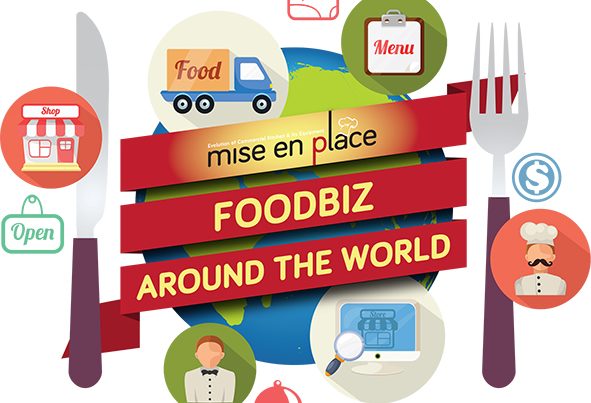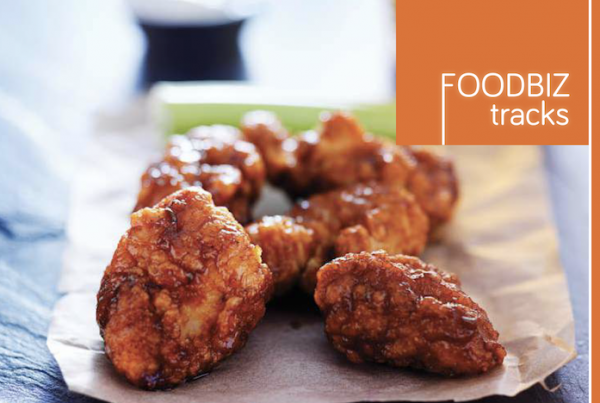
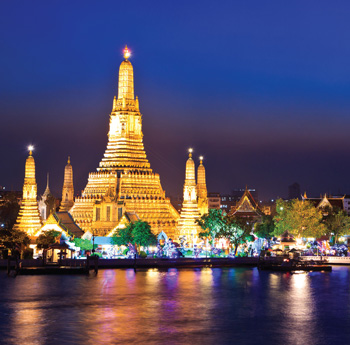 Have a conversation with about almost anyone about their travels and they’ll tell you about their recent excursion, future plans to visit or revisit the Land of Smiles: Thailand. Formerly known as Siam, this country is at the centre of the Indochinese peninsula in Southeast Asia. Despite it’s chaotic politics, the country is safe and the culture is humbling yet absolutely fascinating – the Buddhist temples are eye-catching and the wildlife is a huge draw. The weather is usually warm and sunny and there are tonnes of things to see and do. There are hill retreats, jungles, beaches, islands and big bustling cities. And, the shopping and nightlife entertainment are big attractions here for asian and western travellers alike. As for food? Paradise.
Have a conversation with about almost anyone about their travels and they’ll tell you about their recent excursion, future plans to visit or revisit the Land of Smiles: Thailand. Formerly known as Siam, this country is at the centre of the Indochinese peninsula in Southeast Asia. Despite it’s chaotic politics, the country is safe and the culture is humbling yet absolutely fascinating – the Buddhist temples are eye-catching and the wildlife is a huge draw. The weather is usually warm and sunny and there are tonnes of things to see and do. There are hill retreats, jungles, beaches, islands and big bustling cities. And, the shopping and nightlife entertainment are big attractions here for asian and western travellers alike. As for food? Paradise.
Eating out is a common occurrence in the country. Thais usually eat out not just on special occasions, but also as a regular part of their social life. Asian food, however, is most popular among the locals due to the copious amount of outlets and variety of menus. Thai food is known predominantly for it’s chilli ‘kick’ and the way its combination of flavours dance when you eat their local dishes. With outdoor stalls all over the streets of Thailand at any time of the day and night, you are constantly being served the cheapest and best Thai meals/dishes you can set your eyes on. And, thanks to the hordes of tourists and expats, there are a lot of savoury international food in the country. You can find sushi restaurants, amazing halal and Indian food usually in the Sukhumvit area of Bangkok. Here, you will also find Mexican and American food too. Find yourself planning a business trip into Thailand soon? Here are some facts and figures that may help you begin somewhere:
FACTS:
Land area: 513120.674 sq.km
Population: 67,400,746
Population density: 131.36 per sq.km
Currency: Thai Baht (THB)(USD 1.00 is equivalent to THB 35.09)
Source: 2015, Statistic Times
DID YOU KNOW?
Thailand is attracting young, independent entrepreneurs entering consumer foodservice with novel and exciting cuisine. These young entrepreneurs are predominantly seen in various locations throughout Bangkok and metropolitan areas. They use social media as a means to attract customers, which was considered a new marketing tool for independent street stalls and kiosks in Thailand. It is perceived that this channel of communication between foodservice brands and their customers will continue to grow and support the strong performance of consumer foodservice.
MAJOR ECONOMIC HUBS
Places of interest listed below are areas known to be most thriving in terms of demographic’s spending power and other factors such as tourism, well-developed infrastructure to be key points for F&B investors:
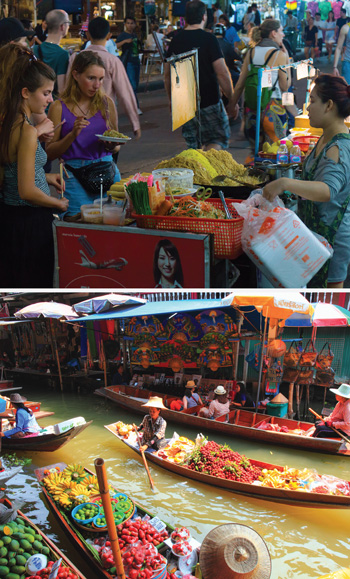
BANGKOK
The city has a multifaceted personality where megamalls sit side-by-side with 200-year-old village homes and royal gold Buddhist temples. Street food can be found in every part of the city. And with immigration bringing every regional Thai and international cuisine to the capital, it’s also a truly diverse experience.
Bangkok’s Floating Markets
Even though transactions are more concerned with tourists rather than locals these days, the floating market boats are still piled high with tropical fruit and vegetables, fresh, ready-to-drink coconut juice and local food cooked from floating kitchens located right on the boat.
Locations: Taling Chan Market, Bang Ku Wiang Market, Tha Kha, and Damnoen Saduak.
Cost of Living Index (Excl.Rent) : 49.05
Rent Index : 25.04
Groceries Index : 52.62
Restaurants Index : 25.97
Cost of Living Plus Rent Index : 37.60
Local Purchasing Power : 48.85
CHIANG MAI
The northern capital is an escape from the whirlwind pace of life of its southern rival. It is calmer than Bangkok and is much older than it appears. The monasteries still remain, centred on ancient brick chedi (stupas) in a remarkable range of shapes and styles, but the gaps between them have been filled in with modern Thai houses and traveller hotels. Despite this, the historic centre of Chiang Mai still feels overwhelmingly residential, more like a sleepy country town than a bustling capital.
Cost of Living Index (Excl.Rent) : 43.27
Rent Index : 11.87
Groceries Index : 53.17
Restaurants Index : 20.23
Cost of Living Plus Rent Index : 28.29
Local Purchasing Power : 32.29
PHUKET
The biggest island in Thailand, Phuket’s (pronounced with the ‘h’ being silent) sin city of Patong is the biggest town and busiest beach. The island’s tendency for luxury far outshines its other stereotypes. Jet-setters come through in a flock for its swanky spa sessions and sipping mimosas at fashion-forward nightspots or on rented yachts. With deep-sea diving, high-end dining, luxury shopping, fabulous white beaches and some of Thailand’s swankiest hotels, its no wonder its everyone’s favourite island destination.
Cost of Living Index (Excl.Rent) : 49.76
Rent Index : 14.06
Groceries Index : 53.29
Restaurants Index : 25.90
Cost of Living Plus Rent Index : 32.74
Local Purchasing Power : 44.01
FOOD SETUPS
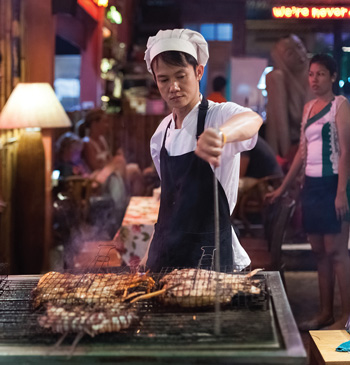
The country’s biggest culinary centres are Bangkok and Chiang Mei as it boasts the cream of gourmet restaurants and the best of international cuisines. But it’s not to say that the rest of the nation is a gastronomic wasteland. You can eat well and within a reasonably cheap price in even the smallest provincial towns, many of which offer the traditional attraction of regional specialties. In fact, you can fill your stomachs from dusk till dawn.
Hygiene is a big consideration when dining anywhere in Thailand, but being too cautious means you’ll end up spending a lot of money and missing out on some real local treats. Wean your stomach gently by avoiding excessive amounts of chillies and too much fresh fruit in the first few days.
Most restaurants in Thailand are open every day for lunch and dinner. In a few of the country’s most expensive restaurants, mostly in Bangkok, a ten percent service charge and possibly even seven percent VAT may be added to your bill.
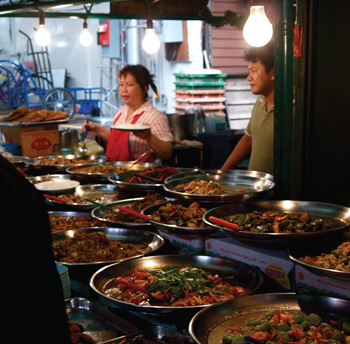 STREET STALLS & KIOSKS
STREET STALLS & KIOSKS
These independent, family-owned businesses dominate the foodservice industry, according to the Market Access Secretariat global analyst report. As mentioned before, Asian cuisine is in an abundance of options especially within this sector serving Thai, Japanese and Korean foods. Street stalls and kiosks are fragmented category, with chains accounting for only 14 per cent of value sales and 13 per cent of outlets in 2015. Among the chained brands, Charoen Pokphand Foods PCL was the leading player in street stalls/kiosks in 2015 with a value share of six per cent. Its products include Five Star Grill Chicken, Five Star Fried Chicken and other Five Star brands.
As the economy was slowly recovering in the beginning of 2015, consumers continued to substitute more expensive meals at full-service restaurant with street stall meals and fast food due to their more affordable prices. The latter half of the year saw a slight growth in the economy, which led to the opening of new shopping malls, condominiums and office buildings. This attracted more street stalls and kiosks to expand their outlets and contributed to the rise of the street stalls and kiosks category.
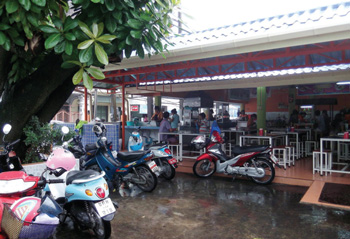 TOP PICK – LOCK TIEN FOOD COURT
TOP PICK – LOCK TIEN FOOD COURT
Phuket old town has some of the most amazing places to eat. It gives the visitors a chance to explore authentic Thai flavours. Lock Tien Food Court in Phuket is basically a collection of several local food stalls, which collectively serve the best food you can find in Phuket. Among the dishes included on the menu are Mee hoon pah chang, which is fried noodles with pork bone soup, lo bah, a deep fried tripe with fried tofu and spicy sweet and sour sauce, mee nam hokkn, a noodle soup with prawn and a lot more.
Speciality Pork bone soup, Fried tofu
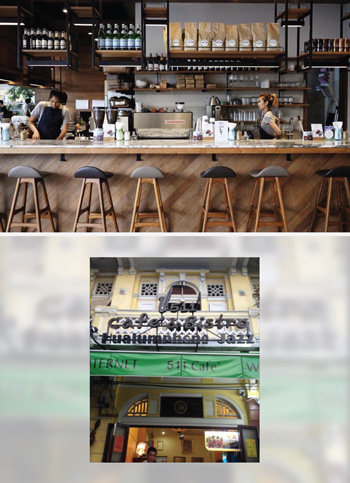 CAFE & BARS
CAFE & BARS
Thailand’s slow economy of 2015 impacted the performance of bars and pubs whose service was slightly more expensive at the beginning of that year. In addition, as foreign tourists make up a high proportion of bar-goers in Thailand, the unfortunate event that happened in the centre of Bangkok in August 2015 deterred a number of foreign visitors and adversely affected a lot of these establishments. The changing behaviour of Thais towards a healthier lifestyle also contributed to this shift on spending on alcohol and nightlife to healthy activities.
And although social media was widely used by brands to communicate and interact with their customers, smart phones or messaging apps were not commonly used. As Thais are becoming more digitalised and familiar with online purchasing, online ordering through smart phone apps could be another channel to boost sales, especially in specialist coffee shops whose customers are technology literature.
TOP PICK – 511 CAFE
This cafe caters to the local Thai cuisine cafe culture; situated in the hustle and bustle of Bangkok city.
Speciality Thom Kai Kai soup, Pad Thai
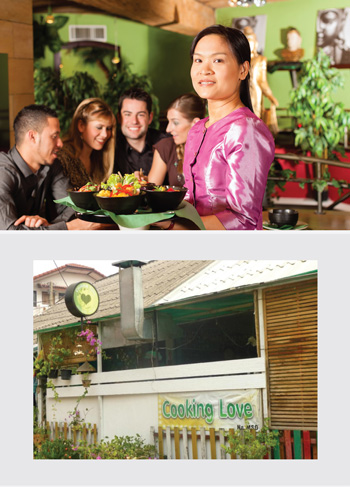 FULL-SERVICE RESTAURANTS
FULL-SERVICE RESTAURANTS
As consumers were becoming more health conscious, full-service restaurant companies started to adapt (more like, required) to this evolving trend. In addition to new healthy food and beverages added to menus, restaurants that specialise in using organic or locally sourced products were also gaining popularity. Restaurants with salad bars were becoming an attractive choice in 2015. Asian full-service restaurants, especially those serving Thai and Japanese also benefited from this trend as the Asian cuisine is generally perceived as a healthier food option by the locals.
Euromonitor forecasts that the Korean and Japanese cultures will continue to be strong influences in the country as Asian full restaurants, especially ones that specialise in these two individual cuisines, are expected to perform well. In addition, companies in the healthy food business could potentially see gain as Thais are paying more attention to what they eat now.
TOP PICK – COOKING LOVE
The restaurant is open-air, so in the summer it can get quite hot. It is a small place, but has a pleasant atmosphere. Locals and tourists flock to this place to have their homemade Thai delicacies.
Specialty Mango Curry Chicken, Vegetable Spring Rolls
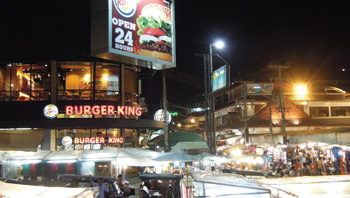 FAST FOOD
FAST FOOD
International brands specialising in vastly different fast food cuisines entered the fast food progression in the country back in 2015. Some examples were chicken fast food brands, such as Taiwan’s Hot Star and USA’s Texas Chicken, and premium burger brands such as Teddy’s Bigger Burgers. Brand loyalty already existed with the long-term brands in the market but the arrival of foreign brands sure increased market competition. Therefore, 2015 saw active marketing campaigns and rapid outlet expansions from existing brands.
New ordering technology is expected to be used widely by chains and other fast food categories, in order to bring in more technologically literate customers. Personalisation in food ordering is also seen to be a big supporting factor as it could increase sales per transaction by 10 per cent.
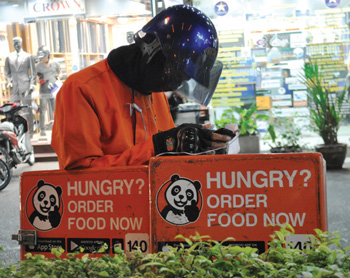 100% HOME DELIVERY/
100% HOME DELIVERY/
TAKEAWAY
While eating out is considered the norm for Thai consumers, busier lifestyles and bad traffic congestion are among the main contributing factors for 100 percent home delivery/takeaway’s growth in 2015. Smart phones and the internet are common lifestyle must-haves for Thais. This prompted 100 per cent delivery/takeaway brands to develop platforms such as online ordering, social media tools such as Facebook and smart phone applications to accommodate the growing demand of users who want to make their orders online. While online ordering was growing at a fast rate, phone ordering is still the most common option, especially for the people of a much earlier generation who are used to making phone orders. Some customers also believe their demands would still be better met via a call centre.
Online ordering and third-party ordering and delivery service are expected to increase over the and this is partly due to brands adapting to the more digitalised Thai lifestyle and expanding network of restaurants and delivery channels offered by third-party ordering and delivery service such as the infamous Foodpanda.
FOOD PRICES
- Street Food: Hawker food is a popular attraction for tourist and a preferred option for many of the locals.
- Food Courts: Found mostly in popular malls and frequented by working professionals in the city and usually has a large variety of food.
- Cafés: Independent or chain cafes, in shoplots or malls around the city.
- Hotels: The top tier of dining
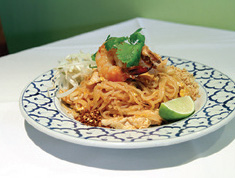 PAD THAI
PAD THAI
Arguably the most popular street food made with medium sized stirfried noodle stirred with eggs and chopped tofu and flavoured with a fish sauce, lime juice or tamarind pulp. A spoon full of sugar or vinegar or chilli flakes would be a perfect choice as condiments for this dish.

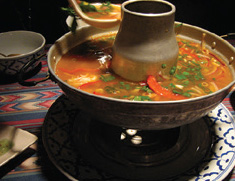 TOM YUM
TOM YUM
The Tom yam’s distinctive hot, spicy and sour taste makes it one of the Thai cuisine trademark dishes. The broth is usually made from fish sause, lemongrass, kaffir lime leaves, lime juice and crushed peppers. The citrus ingredient inside the soup gives the dish a great depth of flavour.

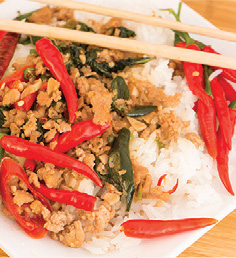 PAD KRA PAO GAI
PAD KRA PAO GAI
Pad Krapao is also known as Thai basil chicken. It’s pretty hard to ruin this dish and that’s one of the main reasons why this dish is the one of the easiest dishes to make in Thailand.


THAI BUSINESS LAWS

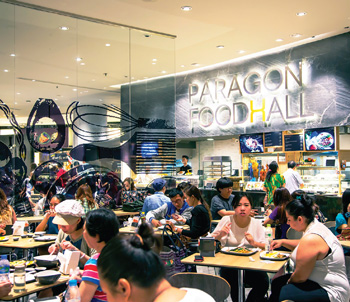 If you want to start a restaurant in Thailand the first question you will have to ask yourself is: Can a foreign investor legally open a restaurant in Thailand? The answer is no. Restaurant and Bar businesses are service activities under the Foreign Business Act List 3 which activities may be exercised by foreign investors only upon applying and receiving a Foreign Business License. The only exceptions are US Citizens who benefit of the US Amity Treaty and may operate a restaurant under a 100 per cent US form.
If you want to start a restaurant in Thailand the first question you will have to ask yourself is: Can a foreign investor legally open a restaurant in Thailand? The answer is no. Restaurant and Bar businesses are service activities under the Foreign Business Act List 3 which activities may be exercised by foreign investors only upon applying and receiving a Foreign Business License. The only exceptions are US Citizens who benefit of the US Amity Treaty and may operate a restaurant under a 100 per cent US form.
When it comes to the intent to operate a business as a foreigner in Thailand the approval requirement under the Foreign Business Act B.E. 2542 must be complied with. Foreigners can be granted a foreign business license for certain business categories (or may be granted an exemption based on a treaty or specific act (investment promotion).
The Foreign Business Act in Thailand divides businesses into three categories:
List 1 Generally businesses listed in list 1 are absolutely prohibited to foreigners unless there is an exemption contained in a special law or treaty.
List 2 Refers to businesses owned by foreigners that were in existence and actually operating prior to the enactment of the Foreign Business law. These businesses are permitted to apply for a special Alien Business license and to continue operating. Foreigners, however, are not permitted to start new businesses listed in this category unless they obtain special permission from the Minister with the approval of the Cabinet.
List 3 These businesses are treated in a manner similar to those in list 2 except that the power to grant an Alien Business License to foreigners who wish to start a new business is vested with the Director General and a committee. Exemptions are possible under the Treaty of Amity and Economic Relations between the Kingdom of Thailand and the United States of America. Also, the Board of Investment may grant exceptions for businesses covered by Lists 2 and 3.
WORKING HOURS
The maximum number of work hours is eight per day or 48 per week, except for work deemed by law to be hazardous, in which case employment is limited to seven hours per day and 42 hours per week. Overtime compensation must be paid at a rate of between 1.5 to three times the normal hourly rate to qualifying employees.
Employees are entitled to 13 national holidays per year, plus a minimum of six days of vacation after one year of consecutive work. Thirty annual paid sick days is standard, and an employer may require a doctor’s certificate for sick leave of three days or more. Female employees are entitled to 90 days of maternity leave, including 45 days of paid leave. The minimum daily wage rate varies, depending upon location, from $4 to $5.
The complexities of the Thai language can be hard to grasp, but English is widely spoken. Picking up at least a smattering will earn you great respect, and help you gain advantage in the daily haggling stakes.
www.dbd.go.th/dbdweb_en/
RELATED ASSOCIATIONS
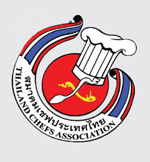 Thai Chefs’ Association
Thai Chefs’ Association
This association has been the driving force in setting up a national standard of Thai Chefs Certificates along with the requirements of the international skills development, to endorse the know-how of cooks, to be able to work in Thai Restaurants overseas.
www.thailandchef.in.th/
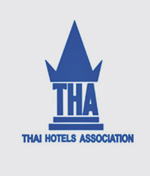 Thai Hotels Association
Thai Hotels Association
Thai Hotel Association was established in 1963 to foster the spirit of unity among members and support each other in hotel industry, support tourism in the country with cooperation from tourism organisations in both Thailand and overseas and finally, to impart knowledge and coordinate among members without involving politics.
thaihotels.org/
WHAT’S IN STORE FOR YOU AND THAILAND?
People are usually excited at the thought of starting a business in Thailand as they become enamoured by the lifestyle. That said, consumer foodservice is expected to improve over the forecast period. The major supporting factors are expected to derive from the strong performance of Asian full-service restaurants, pizza full-service restaurants, and independent street stalls/kiosks. Meanwhile, the healthier lifestyle of Thais is likely to pose challenges to fast food and bars/pubs over the forecast period. Bangkok and metropolitan areas will be key destinations of a variety of consumer foodservice outlets inspired by the chic and modern lifestyle of urbanisation. The Asian trend from Japan, Korea and Taiwan is expected to remain the key theme of setting up new restaurants and outlets.
Source: 2015, Euromonitor International
UPCOMING EVENTS
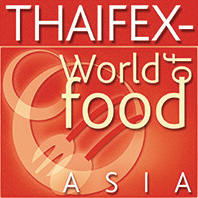 THAIFEX
THAIFEX
31st May – 04 June 2017
IMPACT Exhibition and Convention Centre Bangkok, Thailand
Announcing the 3rd phase of expansion, THAIFEX-World of Food Asia will be Asia’s largest F&B show in Asia, with a gross floor area of 93,500 sqm. The exhibition will present 3 other specialised trade events and 12 different product segments, across 9 halls.
www.worldoffoodasia.com/

TRAFS: THAILAND RETAIL,
FOOD & HOSPITALITY SERVICES
13 – 16 July 2017
BITEC Bangkok
In its 11th edition, TRAFS 2017 is Thailand’s biggest premier industry focused exhibition on Hotels, Food Service and Retail. With strong supports from industry’s associations in Thailand and overseas, TRAFS 2017 has incorporated plentiful activities from seminars to workshops and competitions by industry professionals.
www.thailandhoreca.com/

FHT: FOOD HOTEL THAILAND
06 – 09 September 2017
Hall 103 – 105, BITEC Bangkok
FHT is the leading premium international trade exhibition for food and hospitality business in Thailand and the region. FHT has a proven track record over 24 years of presenting new products and services from the world’s best companies, and delivering business for exhibitors.
www.foodhotelthailand.com/







